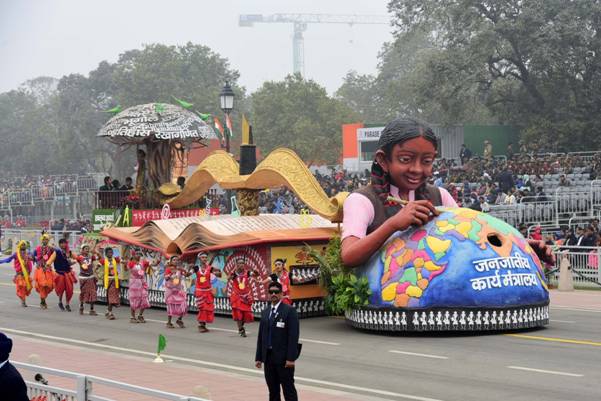Extended Range Anti-Submarine Rocket (ERASR)

- 13 Jul 2025
In News:
India recently conducted successful user trials of the Extended Range Anti-Submarine Rocket (ERASR) from INS Kavaratti, marking a significant milestone in strengthening the country’s anti-submarine warfare (ASW) capabilities through indigenously developed technologies.
What is ERASR?
The ERASR is a state-of-the-art anti-submarine rocket system designed to neutralize hostile submarines from Indian naval warships. It is specifically intended for launch from Indigenous Rocket Launchers (IRLs) onboard Indian Navy ships.
- Developed by: Defence Research and Development Organisation (DRDO), specifically the Armament Research & Development Establishment (ARDE), Pune, in collaboration with the High Energy Materials Research Laboratory and Naval Science & Technological Laboratory.
- Production partners: Bharat Dynamics Limited (Hyderabad) and Solar Defence & Aerospace Ltd. (Nagpur).
Key Features
- Twin Rocket Motor System: Enables engagement of both short- and long-range submarine targets with high accuracy and consistency.
- Electronic Time Fuze: Fully indigenously developed to ensure precise detonation near underwater threats.
- High Operational Reliability: Demonstrated through consistent warhead detonation and fuze performance.
- Launch Compatibility: Designed to be fired from frontline warships equipped with Indian-made rocket launchers.
Highlights of User Trials
- Conducted from: INS Kavaratti under simulated maritime combat conditions.
- Number of Rockets Tested: 17
- Parameters Evaluated:
- Range performance
- Fuze timing reliability
- Warhead detonation effectiveness
- Outcome: All trial objectives were met; system demonstrated full battlefield readiness.
Significance
- Strengthens India’s ASW capabilities in the Indian Ocean Region, a vital strategic space.
- Boosts Atmanirbharta in defence by reducing reliance on foreign imports.
- Economically efficient, as the scalable domestic production replaces high-cost foreign systems.
- Reflects DRDO’s technological maturity in delivering mission-ready, indigenous defence solutions.
Optical Atomic Clock

- 13 Jul 2025
In News:
In a landmark advancement, an international team of 65 scientists from six countries conducted the world’s largest and most accurate optical atomic clock comparison across three continents. This is a major step towards redefining the SI unit of time — the second — using optical atomic clocks instead of current caesium-based clocks.
Current Definition of a Second
- Defined since 1967 by the International System of Units (SI):
One second is the time it takes for 9,192,631,770 cycles of microwave radiation emitted during the transition between two hyperfine levels of the ground state of a caesium-133 atom.
- In India, the National Physical Laboratory (NPL) in New Delhi maintains the time standard using five caesium atomic clocks, disseminating the output via INSAT satellites, telecom signals, and fibre links.
Why Redefine the Second?
Limitations of Caesium Clocks:
- Frequency: 9.19 billion Hz (microwave range).
- Stability: Drifts by 1 second every 300 million years.
- Insufficient for the growing precision demands of:
- Global Positioning Systems (GPS, NavIC, Galileo)
- Climate science (e.g., measuring gravity changes due to ice loss)
- Radio astronomy (e.g., black hole imaging)
- Quantum technologies and space navigation
Optical Atomic Clocks: The Next Time Standard
Advanced atomic clocks that use visible light (optical frequencies) rather than microwaves to measure atomic transitions, allowing much higher precision.
Atoms Used:
- Strontium-87 (Sr)
- Ytterbium-171 (Yb)
- Charged Ytterbium Ions (Yb? E2, Yb? E3)
- Charged Strontium-88 (Sr?)
- Indium-115 ions (In?)
Working Principle:
- Atoms are held in optical lattices or ion traps.
- A laser, tuned to the atom’s natural frequency, stimulates atomic transitions.
- The resulting oscillations — which occur hundreds of trillions of times per second — are counted to define one second.
Superior Attributes:
- Frequency range:
- Strontium: 429 trillion Hz
- Ytterbium: 642 trillion Hz (≈ 10,000 times greater than caesium clocks)
- Unmatched stability: Drift of 1 second in 15 billion years in some cases
- Precision: Agreement between clocks within 10?¹? to 10?¹?, enabling ultra-precise synchronization globally
The Global Clock Comparison: Key Highlights
Objective:
To test whether optical clocks across the world remain synchronized at ultra-high precision, a prerequisite for redefining the SI second.
Experiment Overview:
- Duration: 45 days (Feb 20 – Apr 6, 2022)
- Participants: 10 optical clocks across six countries (Germany, France, Italy, Japan, Finland, UK)
- Atoms used: Sr, Yb, Sr?, Yb? (E2 & E3), In?
- Techniques:
- Optical fibre links between countries
- Advanced GPS method: Integer Precise Point Positioning (IPPP)
- Backups: GPS-based clocks during maintenance downtime
Key Outcomes:
- 38 independent frequency ratios measured — most extensive comparison to date
- 4 new ratios measured for the first time, including:
- Yb?(E3) to Yb
- In? to Yb
- Sr? to Sr
- Sr? to Yb
- Precision Achievements:
- Sr clocks in Germany and France: differed by < 2 × 10?¹?
- In? and Yb?(E3) clocks in Germany: matched within 4.4 × 10?¹?
- Germany–UK clocks: matched within 3 × 10?¹? via GPS, even with downtime
Challenges & Corrections Identified
- Italy’s Yb clock showed a consistent offset of 4 × 10?¹? in GPS-based ratios due to a signal distribution glitch.
- France and Germany’s Sr clocks showed small but real mismatches (~2 × 10?¹?), needing further investigation.
- Error Correlation Matrix: A 38×38 matrix with 242 non-zero correlation coefficients was created to responsibly combine data and avoid double-counting.
Significance for India and the World
- By 2030, optical atomic clocks are expected to officially redefine the second.
- India, through NPL, will need to upgrade infrastructure to remain in sync with the new global standard.
- Enhanced time precision will benefit:
- ISRO’s navigation and deep space programs
- Disaster response using satellite geolocation
- Quantum communication and computing
Catastrophe Bonds (Cat Bonds)
- 13 Jul 2025
In News:
Life insurance is common in India, but disaster risk insurance is not. Low coverage leaves most assets and livelihoods uninsured and vulnerable to loss. Globally, after the late-1990s U.S. hurricanes impacted even re-insurers, catastrophe risk began shifting to financial markets via catastrophe bonds (cat bonds).
What are Catastrophe Bonds (Cat Bonds)?
Catastrophe bonds (cat bonds) are insurance-linked securities (ILS) that convert disaster risks into tradable debt instruments, allowing countries or insurers to transfer the financial burden of natural disasters to capital markets.
- They are high-yield bonds issued by governments or insurance entities (sponsors) via intermediaries like the World Bank or Asian Development Bank.
- In case of a pre-defined disaster event (e.g., a 7.0 magnitude earthquake or 250 km/h cyclone), investors lose part or all of the principal, which is used by the sponsor for relief and reconstruction.
- If no disaster occurs, investors receive attractive coupon payments and their principal is returned at maturity.
- A Special Purpose Vehicle (SPV) is created to manage funds, isolate risks, and ensure legal and financial transparency.
Why Cat Bonds Matter
India is one of the most disaster-prone countries in the world, experiencing regular cyclones, floods, landslides, earthquakes, and forest fires. Despite this:
- Insurance penetration remains low, leaving individual property and livelihoods largely uninsured.
- The fiscal burden of post-disaster recovery typically falls on government budgets, disrupting planned expenditure and long-term development projects.
As a solution, cat bonds offer pre-arranged, parametric-trigger-based disaster financing, enabling faster payouts and risk diversification.
Advantages of Cat Bonds
|
Benefit |
Explanation |
|
1. Fast Payouts |
Unlike conventional insurance, cat bonds disburse funds immediately after a trigger event. |
|
2. Fiscal Resilience |
Shields government budgets from sudden disaster-related shocks. |
|
3. Diversified Risk |
Catastrophic risks are uncorrelated with financial markets, offering true portfolio diversification. |
|
4. Broader Capital Base |
Taps into global capital markets, beyond traditional reinsurance capacities. |
|
5. Encourages Mitigation |
Countries with better disaster preparedness may attract lower premiums. |
Cat bonds also appeal to institutional investors, especially pension funds and hedge funds, seeking returns that diversify portfolio risk away from traditional market-linked assets.
Limitations and Challenges
|
Limitation |
Explanation |
|
Trigger Rigidity |
No payout if the event falls just short of the pre-set parameters (e.g., a 6.5 magnitude quake when 6.6 is the threshold). |
|
Design Complexity |
Requires precise, data-backed modeling; poor design may exclude real risks. |
|
Perception of Waste |
In resource-scarce settings, non-triggered bonds may be seen as wasteful. |
|
High Premiums |
Hazard-prone regions attract higher premiums, potentially reducing cost-effectiveness. |
Transparent design, clear actuarial modelling, and historical comparisons with actual relief costs are critical for effective implementation.
India’s Readiness for Cat Bonds
- Annual Allocation: ?1.8 billion allocated since FY21–22 for disaster mitigation and capacity building shows India’s proactive approach to risk reduction.
- Sovereign Credibility: India’s stable credit rating and large economy make it a credible sponsor for such instruments.
- Hazard Exposure: Increasing frequency and severity of climate-induced disasters makes India a suitable case for cat bond-backed financial risk transfer.
Towards a South Asian Cat Bond
Given shared disaster vulnerabilities, India could spearhead a regional catastrophe bond to cover multiple countries facing similar risks:
Benefits:
- Regional risk pooling reduces premium costs.
- Enables a broader hazard matrix (e.g., cyclones in Bay of Bengal, earthquakes in Himalayan belt).
- Enhances regional financial resilience and climate cooperation.
Possibilities:
- An earthquake bond covering India, Nepal, Bhutan
- A cyclone bond for India, Bangladesh, Sri Lanka, Maldives, Myanmar
Such instruments would address unhedged regional risks and promote disaster preparedness in South Asia.
Global Context
- $180 billion: Approximate global issuance of cat bonds since inception.
- $50 billion: Currently outstanding in global cat bond markets.
- Post-1990s hurricanes in the US catalyzed growth in this market, especially as reinsurers struggled to bear repeated losses.
Bulgaria to join the Eurozone in 2026
- 13 Jul 2025
In News:
Recently, the EU finance ministers officially approved Bulgaria’s adoption of the euro, set to take effect from January 1, 2026. This decision marks Bulgaria as the 21st member of the Eurozone, nearly 19 years after it joined the European Union in 2007. The euro will replace the Bulgarian lev at a fixed exchange rate of 1 euro = 1.95583 lev.
About the Eurozone
- The Eurozone comprises EU member states that have adopted the euro (€) as their official currency and fall under the monetary jurisdiction of the European Central Bank (ECB).
- The euro was introduced in electronic form in 1999 and entered physical circulation in 2002 across 12 initial member states.
- As of now, 20 countries use the euro, with Croatia being the latest entrant in 2023. Bulgaria will become the 21st in 2026.
Maastricht Convergence Criteria
To adopt the euro, EU member states must satisfy strict economic criteria to ensure stability and convergence with the Eurozone economies:
- Price Stability: Inflation should not exceed 1.5 percentage points above the average of the three best-performing EU states.
- Sound Public Finances:
- Fiscal deficit ≤ 3% of GDP
- Gross government debt ≤ 60% of GDP
- Exchange Rate Stability: The national currency must be part of ERM-II (Exchange Rate Mechanism) for at least 2 years without severe fluctuations.
- Interest Rate Convergence: Long-term interest rates must not exceed the average rates of the three lowest-inflation member states by more than 2 percentage points.
After years of delay due to high inflation, Bulgaria recently fulfilled all these criteria, leading to EU and ECB approval.
About Bulgaria
- Location: Southeastern Europe; occupies the eastern Balkan Peninsula.
- Borders:
- North: Romania
- South: Turkey & Greece
- West: Serbia & North Macedonia
- East: Black Sea
- Geography:
- Major mountain ranges: Balkan Mountains, Rhodope Mountains
- Highest peak: Mount Musala (2,925 m) in the Rila Mountains
- Rivers: Danube, Iskur, Maritsa, Struma, Tundzha, Yantra
- Climate: Mostly continental; southern areas influenced by the Mediterranean.
- Capital: Sofia
- Population: ~6.4 million
Eklavya Model Residential Schools

- 13 Jul 2025
In News:
In a significant milestone for tribal education in India, nearly 600 students from Eklavya Model Residential Schools (EMRSs) across 12 States have successfully cleared top national-level entrance exams like IIT-JEE (Mains & Advanced) and NEET 2024, as per the recent performance assessment by the Ministry of Tribal Affairs. This marks a remarkable improvement in academic outcomes for Scheduled Tribe (ST) students in government-run residential schools.
Breakdown of Performance (2024-25):
- IIT-JEE Mains: 218 students qualified; ~25 expected to secure admission in NITs.
- IIT-JEE Advanced: 34 students qualified; 18 likely to get admission into IITs.
- NEET: 344 students qualified; 3 expected to be placed in AIIMS, others in top government medical colleges.
This is the first comprehensive data compilation for EMRS performance in national competitive exams, a sharp increase from earlier years when only a few dozen tribal students achieved similar success.
Government Support & Outreach:
To further encourage these meritorious students, the Ministry of Tribal Affairs is launching a dedicated outreach programme:
- Students will be actively supported and hand-held through the post-matric scholarship application process.
- The Scholarship Division of the Ministry will proactively connect with all qualifying students to ensure they receive their entitled financial support.
- This initiative reflects a paradigm shift from passive support to active facilitation.
Institutional and Policy Framework:
- EMRS is a flagship scheme under the Ministry of Tribal Affairs, aimed at providing quality residential education from Class 6 to 12 to tribal students in remote and underdeveloped regions.
- Introduced in 1998, the programme was revamped in 2018–19 to enhance infrastructure and expand coverage.
- Schools are being established in blocks with >50% tribal population and at least 20,000 tribal persons.
- The government has targeted the establishment of 728 EMRSs by 2026.
- The National Education Society for Tribal Students (NESTS), an autonomous body under the Ministry, is tasked with operationalizing these schools.
Key Features of EMRS:
- Co-educational residential schools from Class VI to XII.
- Follow CBSE curriculum; completely free education.
- Special focus on local tribal culture, sports, and skill development.
- Each school has a capacity of 480 students, with gender parity in enrolment.
- Reservation norms: 10% for non-ST students; 20% under sports quota for ST students excelling in sports.
- Infrastructure includes academic blocks, hostels, teacher accommodations, labs, sports grounds, and cultural activity spaces.
Recent Initiatives and Recognition:
- The success is partly attributed to strategic partnerships with reputed coaching institutes facilitated by NESTS for IIT-JEE and NEET preparation.
- Around 85% of EMRS students belong to Scheduled Tribes, including Particularly Vulnerable Tribal Groups (PVTGs).
- The achievements were acknowledged in a high-level review meeting chaired by Union Tribal Affairs Minister Jual Oram and MoS Durgadas Uikey, who lauded the efforts of teachers, administrators, and students.
